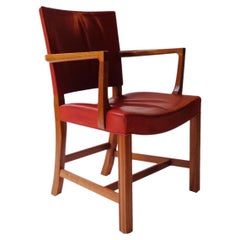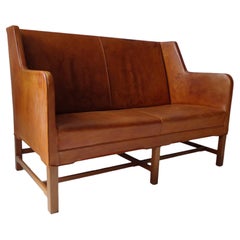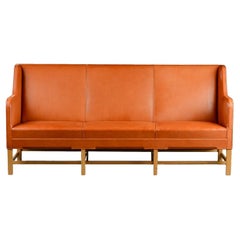Rud Rasmussen Furniture
Exemplary designs for wood chairs, cabinets, desks and tables are part of the legacy associated with Rud Rasmussen, an iconic Danish furniture manufacturer that collaborated with some of the world’s best known and universally revered Scandinavian modernists.
Rud Rasmussen Snedkerier was established in 1869 in Copenhagen. The workshop’s founder, cabinetmaker Rudolph Rasmussen, was raised in a family of carpenters and had initially specialized in oak furniture. It wasn’t long before the business had grown — in 1876, Rasmussen was operating out of a four-storey factory, and by the end of the 19th century, the manufacturer had forged relationships with esteemed Danish architects including Vilhelm Dahlerup and Thorvald Bindesbøll.
With Rudolph Rasmussen's passing in 1904, the founder’s sons, Rudolph and Victor, took control of the company. They realized their father's dream of expanding the business — the firm had by then been accepting commissions from Copenhagen City Hall and was soon producing furniture for the likes of the police station, the postal service, ministries, technical universities and hospitals. More longstanding collaborations with legendary cabinetmakers and architects came into play, too.
Rud Rasmussen partnered with Mogens Koch, Børge Mogensen, Hans Wegner and Kaare Klint, the founder of the design school at Copenhagen’s Royal Danish Academy of Fine Arts. The manufacturer is known to collectors for producing Koch’s versatile bookcases, and, in 1933, Rud Rasmussen debuted Klint’s Safari chair — a clever and timeless interpretation of campaign furniture.
Carl Hansen and Søn acquired Rud Rasmussen in 2011.
Find vintage Rud Rasmussen seating, case pieces and decorative objects on 1stDibs.
1950s Danish Scandinavian Modern Vintage Rud Rasmussen Furniture
Leather, Mahogany
1940s Danish Scandinavian Modern Vintage Rud Rasmussen Furniture
Leather, Mahogany
1970s Danish Scandinavian Modern Vintage Rud Rasmussen Furniture
Leather, Ash
1930s Danish Scandinavian Modern Vintage Rud Rasmussen Furniture
Brass
Mid-20th Century Danish Scandinavian Modern Rud Rasmussen Furniture
Mahogany, Wool
1930s Danish Scandinavian Modern Vintage Rud Rasmussen Furniture
Brass
1930s Danish Scandinavian Modern Vintage Rud Rasmussen Furniture
Brass
1930s Danish Mid-Century Modern Vintage Rud Rasmussen Furniture
Leather, Mahogany
Mid-20th Century Danish Mid-Century Modern Rud Rasmussen Furniture
Mahogany, Leather
Mid-20th Century Danish Mid-Century Modern Rud Rasmussen Furniture
Mahogany, Leather
1940s Danish Mid-Century Modern Vintage Rud Rasmussen Furniture
Fabric, Wood
1930s Danish Scandinavian Modern Vintage Rud Rasmussen Furniture
Brass
1930s Danish Scandinavian Modern Vintage Rud Rasmussen Furniture
Leather, Mahogany
1930s Danish Mid-Century Modern Vintage Rud Rasmussen Furniture
Leather, Mahogany
Mid-20th Century Danish Mid-Century Modern Rud Rasmussen Furniture
Leather, Mahogany




